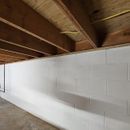Band Joist and Sill Plate Insulation Moisture
Long time reader, first time poster here. Thank you to all who contribute.
So my question has to do with closed cell spray foaming the band joist in my 1976, climate zone 6, ranch home. Initially I was going to spray the band joist, spray down over the sill plate and down on to the cinder block wall about an inch or so. This would completely seal everything in one shot. However, I am concerned about trapping moisture in the sill plate leading to rott…
Sandwiched between the sill plate and the cinder block wall is yellow fiberglass. I assume this would not qualify as a capillary break?
To add to the matter, the sill plate appears to NOT be treated wood. Does treated wood lose its green color after 47 years? Was treated wood not used for sill plates in 1976?
Right now, to err on the side of caution I am leaning towards just spray foaming the band joist. To better air seal the sill plate and sill plate/cinder block interface, I will carefully lay a bead of Great Stuff Pro foam sealant where the sill plate meets the cinder blocks and foaming shut the exposed openings on the top of the cinder block wall. This will still allow the majority of the sill plate to be exposed to the interior for drying purposes should it ever take on water. Please redirect me if this doesn’t sound like the best solution or I am overlooking something.
Please chime in with any other suggestions or considerations, I do appreciate it. Thanks in advance!
(Please ignore the previous homeowner’s electrical wiring)
GBA Detail Library
A collection of one thousand construction details organized by climate and house part










Replies
XCMTB83,
That sounds like a prudent approach. In the absence of a capillary break, it's hard to know how much drying capacity the sill-plate needs to keep it safe. My own preference would be to use squares of rigid foam sealed at the perimeter, but if you are comfortable using spray foam, I don't see a downside.
You a right, the fiberglass isn't a capillary break, and up here in Canada we still often use un-treated lumber for sill-plates (as long as there is an effective sill-seal underneath). It's difficult to tell if old wood is pt or not.
Thanks for the reassurance, Malcom. The other variable I have to consider is I have only lived in this house for the last 2.5+ years, all of which we have technically been in a drought. It would be nice to know, during a wet year if there is any water present and if so, how much capillary action is present. Thanks again for the input.